Infiniti Q50 joins world’s elite sedans
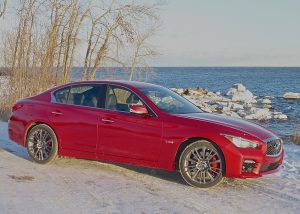
Lean and sleek styling of the new Q50 find a match in the Red Sport’s twin-turbo 3.0 V6 and AWD performance.
By John Gilbert
Even the best cars in the world are met with mixed reactions. But if no car seems capable of being all things to all customers, spend a short time with the Infiniti Q50 and you may decide it comes awfully close.
The Q50 is a sleek midsize sedan, and it can be bought in two forms, which might be considered great and greater. The top model was the one I test-drove for a week in Northern Minnesota, and it was well into winter in Duluth. Which was a good thing, for our test. The car in question was called the Q50 Red Sport 400 AWD, and it had all the goodies Infiniti could fit into that curvacious form, not the least of which was all-wheel drive.
Nissan’s potent 3.0-liter V6 is a new and high-tech powerplant that adds the extra punch of turbocharging. As in high-capacity twin turbochargers, making 400 horsepower with 350 foot-pounds of torque.
A 7-speed automatic transmission doles out all that power to the four wheels, and if you didn’t really care much for maximum fun, you could just leave it in “D” and enjoy its smooth power. Ah, but if you do enjoy driving thrills, you can shift the automatic manually with the best-designed paddle shift levers in the industry.
Companies that install paddles for fingertip shifting almost always mount them on either side of the steering wheel where they can be easily reached by thumbs, ethe right on for upshifting and left for downshifts. That works well, almost all the time.
But if you’re starting up at a T intersection, and you turn 90 degrees while accelerating, you can lose the paddle locations momentarily, usually when you shift hands, and almost always when you lost the exact location of the right paddle. Not with the Q50.
Nissan always has used long, magnesium paddles, attached to the steering column rather than the wheel. That way, if you turn the wheel hard to the left, say, and shift your hands on the wheel, as you run out of revs, you can quickly grab anywhere along the right side and you will find the paddle to upshift. Nissan uses those affixed paddles with the Infiniti Q50, meaning it begs you to shift for yourself.
When Nissan comes out with a new engine, it is always worth close scrutiny, and both engines in the Q50 are new. Without a doubt, the twin-turbo V6 boosts the Q50 to elite sports sedan prestige, comparable to, and maybe superior in some views, to BMW.
However, I am going to make a plea for anyone who is interested to first try the Q50 with the 4. It, too, is turbocharged, and even though it only has 2.0 liters of displacement, it will supply all the enthusiastic spirit you could want. The 3.0 V6 can get up to mid-30 miles per gallon in highway driving; the 2.0 turbo 4 can easily surpass and stay above 30 mpg wherever you drive.
Of course, with all-wheel drive, the Q50 AWD plowed through a 6-inch snowfall we had just up the North Shore of Lake Superior from Duluth, Minnesota, with an ease that was Jeep-like even in such foul winter weather
And here’s the less-known fact: Nissan has an arrangement with none other than Mercedes to build dual-overhead-cam, turbocharged 2.0-liter 4-cylinder engines. I spent some time with the Mercedes crossover SUVs last fall, and whether you drive the GLA, GLC, or the new GLC Coupe, as well as the C or E Class sedans, you start with a base 2.0-liter 4-cylinder turbocharged engine.
What impressed me most when I spent a week driving a Mercedes GLA was that it had plenty of punch. Its computer automatically reset itself for fuel economy each time you started up, and in a week’s time without ever getting it out for a highway road trip, I never once went anywhere up the hills of Duluth when it registered less than 32 miles per gallon.
Even more impressive, after I enjoyed the power, responsiveness and fuel-efficiency of that 4, I learned Nissan had built the engine for Mercedes. With their joint venture, some of these engines are built in various plants around the world. The 2.0 turbo 4 in the C-Class sedan is the same as the 2.0 engine built in Nissan’s Tennessee plant, while the 2.0 4 in the QX30 crossover SUV is built in Germany, then sent to the United Kingdom plant for installation.
It’s confusing, but the Infiniti engine was designed with Daimler as part of the alliance with Nissan, and while Mercedes always has had a legendary reputation with its engines, it is indeed impressive on the resume for Nissan to be building some Mercedes engines. Having the Q50, Q60, and QX30 share a 4-cylinder turbo with the C-Class, CLA, E-Class sedan and wagon, and the SLC roadster is impressive.
The 4-cylinder Q50 starts at $35,000, while the twin-turbo V6 starts at $50,700. The test car I drove had all the specialty Red Sport features. It also had hill-start assist, automatic on-off LED headlights, foglights, brake lights and turn signals. Leather trim on the seats and steering wheel set off the classy interior, which also featured Kacchu aluminum interior trim, rain-sensing wipers, power sunroof, keyless entry and push-button start, Bluetooth phone system, and Bose surround sound.
Two USB ports, cruise, voice recognition for audio, information, and Bluetooth, and the full complement of safety technology also were in place. Dynamic control, brake force distribution, traction control, tire pressure monitoring, and a vehicle immobilizer system all came standard.
The option bin produced the special Red Sport seats, matte-finish natural maple wood trim, adaptive cruise, lane-departure warning and prevention, blind spot warning, predictive collision warning, emergency braking, surround video monitor with moving object detection, backup collision intervention with rear cross-traffic alert, InTouch navigation and voice recognition, and, of course, heated front seats and steering wheel, plus remote start.
All of that lifted the price from the $50,700 Red Sport price to $62,220. That’s a long way up from the $35,000 base price for the 4-cylinder turbo Q50. Which means you can load it up any way you choose. It’s easy to become entangled in the alphabet-soup, or alpha-numeric confusion, of identifying the occupants of Nissan’s luxury branch stable, but we’re now down to the Q50, Q60 and Q70 models among the cars, where the numbers represent size, and are not to be confused with any QX things, such as QX30, QX50, QX60, QX70 or QX80 — all of which are SUVs of ever-increasing size.
As an aside, I can always be accused of favoring the most compact model of a given line, as long as it’s big enough. And in this case, it’s also true, because I found the Infiniti QX30 to be my runaway favorite among Infiniti SUVs, both because of its swoopy, low-slung styling and the inclusion of that 2.0-liter turbo 4-cylinder.
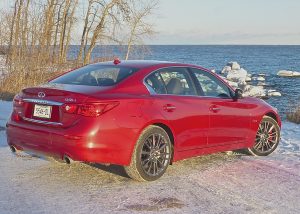
Infiniti makes larger sedans and SUVs, but the Q50 is the sportiest, and, arguably, the most attractive.
It’s hard to say whether consumers are aware of all that intermingling engine-building stuff, but Nissan’s reputation for making strong and sporty engines helped it make the largest gains in sales of any car-maker in 2016. As is the case throughout the industry, trucks led the way. Nissan sold 53,313 trucks in the U.S. in January of 2017, with the Rogue accounting for 28,760 of them, rising 46 percent. Pathfinder increased sales by 13 percent, the Quest minivan 32 percent, and the new full-size Titan pickup up by 195 percent in its reintroduction.
Nissan’s Infinity upscale brand improved SUV sales, too, and overall it increased sales by 36 percent in January 2017 compared to January 2016, with 11,558 sold. It was led by the new nQ50. One test-drive will convince you why.


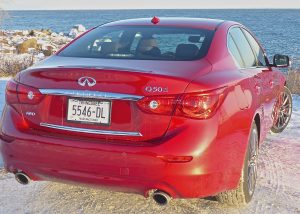
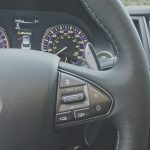
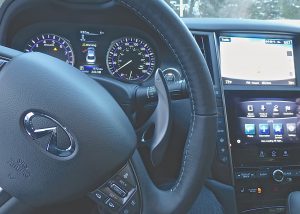
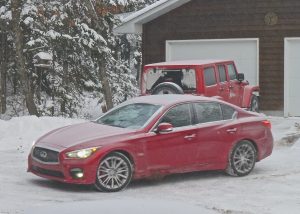
 John Gilbert is a lifetime Minnesotan and career journalist, specializing in cars and sports during and since spending 30 years at the Minneapolis Tribune, now the Star Tribune. More recently, he has continued translating the high-tech world of autos and sharing his passionate insights as a freelance writer/photographer/broadcaster. A member of the prestigious North American Car and Truck of the Year jury since 1993. John can be heard Monday-Friday from 9-11am on 610 KDAL(www.kdal610.com) on the "John Gilbert Show," and writes a column in the Duluth Reader.
John Gilbert is a lifetime Minnesotan and career journalist, specializing in cars and sports during and since spending 30 years at the Minneapolis Tribune, now the Star Tribune. More recently, he has continued translating the high-tech world of autos and sharing his passionate insights as a freelance writer/photographer/broadcaster. A member of the prestigious North American Car and Truck of the Year jury since 1993. John can be heard Monday-Friday from 9-11am on 610 KDAL(www.kdal610.com) on the "John Gilbert Show," and writes a column in the Duluth Reader.